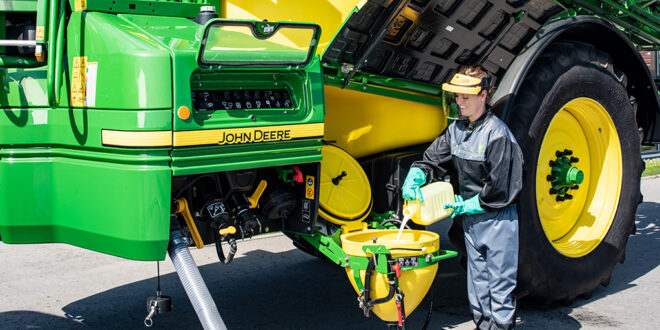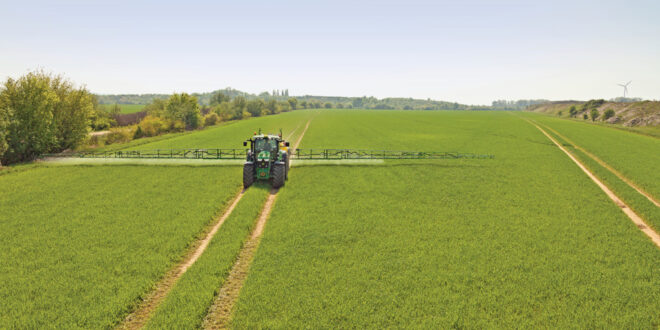Mr Audenaert grew up on an arable farm in the southwest of the Netherlands growing mainly wheat, sugar beet and potatoes. After studying agricultural engineering at Wageningen University he started working in the product engineering department for sprayer manufacturer Douven in Horst. Soon he became a product manager. “I have been intensively involved in sprayers right from the beginning,” he says. After John Deere took Douven over, Mr Audenaert led the development and European launch of a completely new range of sprayers – the 800 Series.

The 800 Series trailed sprayers were launched in 2000 and represented a whole new sprayer concept.
A few years later he moved to John Deere’s European headquarters, in Mannheim, Germany. “I worked on the large arable and contractor segment, and after a major organisational change, I now focus on small grain production systems,” he says. The job title changed from time to time, but spraying technology has been a key expertise throughout his career. “In that respect it is a very special job, which also requires me to travel a lot. I drive up and down from the Netherlands to Mannheim, but also to Kaiserslautern or Zweibrucken in Germany. I also regularly visit the John Deere units in the US.”
Different trends per country

Jørgen Audenaert is an expert in spraying technology. For almost 25 years he has contributed to many technological breakthroughs like data collection, artificial intelligence, sensor technology and pulsing nozzles.
When Mr Audenaert started working in the early 1990s, sprayers were very different. “The main goal was to increase capacity, and farmers were switching from mounted to trailed sprayers,” he explains. “Higher spraying capacity is still important, but trends in spraying technology are surprisingly different from country to country.
“In the Netherlands, for example, we see a lot of ultra-wide spray booms, while Germany is especially interested in very large spray tanks. France is leading in spraying at high speeds and in the UK a lot of spraying is done at low volumes. What all countries have in common is an interest in more automated processes like filling and cleaning the sprayer, as well as increasing spraying precision while reducing the environmental impact.”
“GPS may have been the biggest breakthrough”
In just a few years Mr Audenaert saw more and more automation: Automated steering systems, automatic boom section control, exact filling systems, automatic cleaning and rinsing systems, automatic boom height adjustment and stability control systems. Most of those features are now standard specification on sprayers.
“The introduction of GPS technology may have been the biggest breakthrough I’ve seen, because it enabled site specific spraying. Boom sections can be switched on and off automatically and even individual nozzles can be controlled while spraying,” he explains. “We are now entering a development phase, in which crop protection is becoming increasingly selective and targeted. The focus is on optimising distribution, dosage and coverage to meet the site-specific needs of the crop.”
Legislation drives innovation
According to Mr Audenaert, this innovation trend is based on several drivers. “Society is looking for more sustainability, and legal requirements on the use of crop protection products are increasing. Farmers are also interested in using fewer crop protection products to reduce their costs. At the same time, yield potential can still be increased due to less crop growth interference and more precise and effective control.”
The technological focus has shifted from increasing capacity towards more selective and site-specific spraying. However, Mr Audenaert wants policy makers to act with caution: “The farmer’s interest should not be disregarded, especially when it comes to drift reduction, optimal spray coverage, and the effectiveness of crop protection. In my opinion these needs are not always properly considered.”
Latest developments
Now pulse width modulation nozzles are state of the art: Sometimes they can spray down to plant level. Could it ever get more precise? Mr Audenaert smiles mysteriously: “Of course I cannot tell you everything about John Deere’s plans, but with the high-frequency pulsating nozzle technology ExactApply, we have come a long way.” For the first time it is possible to control the dose rate and the droplet size independently of each other, he explains. “With different speeds you can achieve the same application rate and vice versa, without changing the droplet size.” This is a big breakthrough for precision agriculture, “because it allows the dosage to be varied precisely over a wide application range and for every location in the field.”
So how does Mr Audenaert see the future for spraying technology? “I am thinking especially of developments around data collection and sensor technology, so as to measure even more precisely which treatment each plant on a field should have. Detecting and distinguishing weeds offers great potential for significant savings in herbicides,” he says. “In the long term, I do not rule out the possibility that technology will be able to perform disease recognition at a very early stage. The observation and prediction of crop growth is becoming more precise and that will offer all kinds of new opportunities.”
Algorithms are decisive
According to Mr Audenaert, the future for spray technology largely depends on regulations, particularly for unmanned machines which are operated by algorithms. “To what extent can it be unmanned? Does someone always have to sit on the machine? These questions need to be answered by the legislative authorities.”
Another area in which algorithms can play a major role is in deciding where and what to spray. “It is important to develop good decision algorithms, which can, for example, take information from a biomass map and translate it into the right dose of crop protection product,” says Mr Audenaert. If algorithms are well-proven, the authorities could approve a wider portfolio of crop protection products to be used together with appropriate precision spraying technology. “A chemical like Reglone, for example, is now prohibited for haulm killing in potatoes, but when you spray based on biomass maps, you only need 40-50%. With proper substantiation for its use, this product might still be available.”
But are sprayers still relevant with the increasing restrictions on chemicals? Mr Audenaert thinks so. “People often think fewer products leads to less spraying. I think it’s the other way around: If you want to implement effective crop protection using fewer products, then you must spray more often, but in lower quantities. Currently, rules regarding the use of crop protection products are geared to treating an entire field with the same rate, while technology can be used to spray more precisely. The approval of crop protection products should take technology more into account.”
Deployment of drones
The question also remains whether the advantages are interesting enough compared to other options, says Mr Audenaert. “I think that scouting and collecting data is particularly interesting for farmers. If farmers used drones for spraying, they would not need to have tramlines and could spray under moist soil conditions. But our self-propelled machines can now spray more than 50ha per hour. If you want to reach that capacity with drones, you have to use a lot of them.”

John Deere is committed to sustainable production with even more efficient use of crop protection products.
Keeping technology affordable
According to Mr Audenaert, the “technological end goal” for spraying is to have every plant mapped and provided with the ideal amount of protection. “In the beginning, people are often skeptical and say that something is not worthwhile, or that it will not get that far, like automatic steering systems or individual nozzle control. And later you see it breaking through.”
But are machines that can spray accurately at plant level affordable for farmers? Mr Audenaert thinks for a moment. “Of course, there must always be a payback model for the customer, otherwise it has no future. Some innovations do not seem to break through in the beginning, but later in combination with other technologies or new machines they become beneficial for the customer. Contractors also play a major role. They can invest in the machines and technologies and spread the costs over a broader group of customers.”
Adoption is faster than expected
As far as Mr Audenaert is concerned, the adoption of precision spraying technology is much faster than expected. When a clear benefit is available and communicated to the customer, there will always be a breakthrough. “Site-specific spraying and working with task cards are not always immediately clear to the grower. In the past, it was often complicated to connect systems to each other, but it is getting easier as the years go on. And when sensors become available that recognise weeds and target spray them, I expect this technology to take off.”
The biggest obstacle? As far as he’s concerned, this is uncertainty about crop protection regulations. “Growers don’t know where this is going – they can’t prepare for the future.”
Challenge for John Deere
According to Mr Audenaert, the major challenge for John Deere in the coming years is the same as that for the entire agricultural sector. “We need to produce considerably more food with almost the same amount of land and in a more sustainable way. Higher yields must therefore be achieved with a more efficient use of fertilisers, crop protection products and water.”
Source: Geert Hekkert






